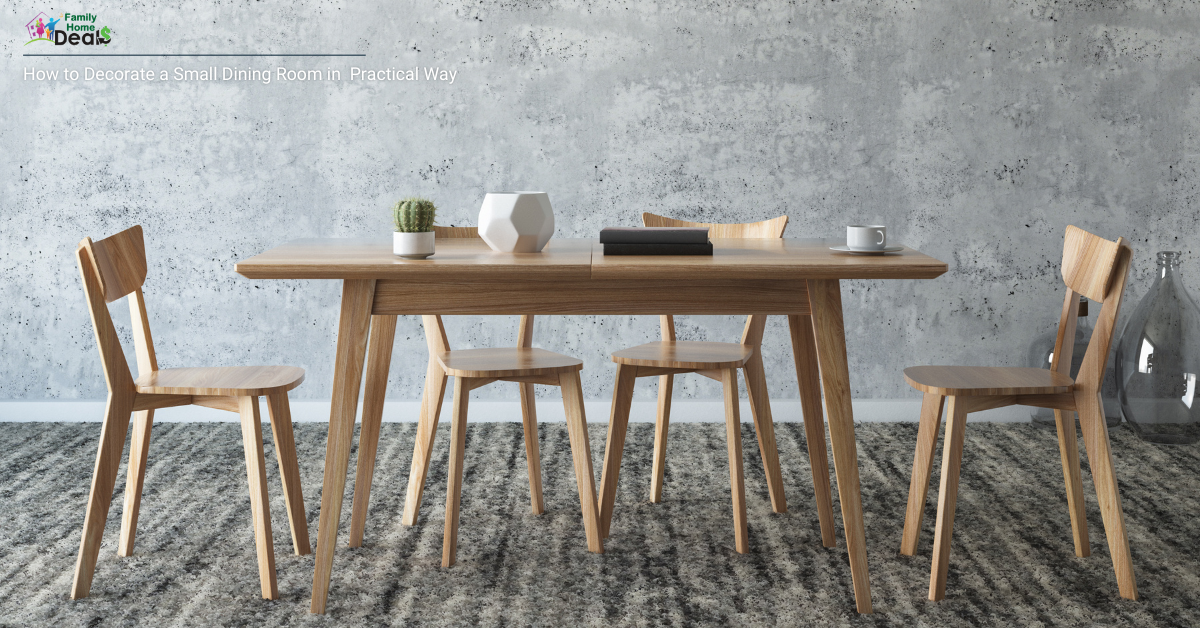Transforming Your Small Dining Room: Simple Tips to Create a Functional and Refreshing Space

If you have a small dining room, you may feel limited in your decorating options. With less space to work with, it can be tricky to strike the right balance between style and functionality. But don’t worry—there are many ways to make your small dining room look stunning while also being practical. With the right approach, you can create a space that feels bigger, works better, and is more enjoyable to use. Whether you’re hosting a dinner party or enjoying a quiet meal at home, a well-decorated small dining room can make all the difference.
In this article, we’ll explore practical and creative ideas on how to decorate a small dining room and make it more functional and refreshing. We’ll cover everything from choosing the right furniture to making the most of your walls, lighting, and decor. By the end, you’ll have a clear plan to transform your small dining room into a space you love spending time in.
How to Decorate a Small Dining Room in Practical and Creative Way
1. Choose the Right Furniture
The furniture you choose plays a crucial role in how your small dining room looks and functions. Since space is limited, every piece of furniture needs to earn its place by being both functional and aesthetically pleasing. The key is to select items that maximize space while still providing comfort and style. Here are some tips to help you make the right choices:
Opt for a Round or Oval Table
Square and rectangular tables can dominate a small dining room, making it feel cramped and difficult to move around. Round or oval tables, however, are perfect for small spaces because they lack sharp corners, making the room feel more open and easier to navigate. These shapes encourage a more natural flow in the room, allowing you to easily move chairs around or walk past the table.
Additionally, round tables create a more intimate dining experience by enabling everyone to face each other, which is perfect for close-knit gatherings. If you’re concerned about space for seating, an oval table can offer the best of both worlds, combining the soft curves of a round table with the extended seating capacity of a rectangular one.
Consider a Drop-Leaf Table
If you need a dining table that can accommodate more people but don’t have the space for a large table all the time, a drop-leaf table is an excellent option. Drop-leaf tables have sections (leaves) that can be folded down when not in use, allowing you to expand or reduce the table’s size as needed. This makes them incredibly versatile for small spaces.
For everyday use, you can keep the leaves down, which gives you more room to move around. But when guests come over, simply extend the leaves to create additional seating space. Some drop-leaf tables are designed with storage underneath, allowing you to store dining essentials like napkins, tableware, or even extra seating cushions, making them even more practical.
Use Benches Instead of Chairs
Chairs can take up a lot of space, especially when they’re pulled out for seating. Benches are a more space-efficient option because they can be tucked under the table when not in use, freeing up floor space and making the room feel less cluttered. Benches can often seat more people than individual chairs, making them ideal for hosting guests in a small dining room. They also contribute to a more casual, communal dining atmosphere.
Additionally, benches come in a variety of styles and designs, from sleek modern looks to rustic wooden options, allowing you to choose one that complements your dining room’s aesthetic. For added functionality, consider a bench with built-in storage beneath the seat—perfect for stowing away placemats, tablecloths, or other dining room essentials.
Multi-Functional Furniture
In a small dining room, every piece of furniture should serve more than one purpose whenever possible. Multi-functional furniture is a game-changer for small spaces, offering both style and utility. For example, a dining table with built-in storage can help you keep your dining room organized by providing space to store dishes, cutlery, or even decorative items like candles or table runners. Some tables come with shelves or drawers integrated into the base, making it easy to keep essentials close at hand while maintaining a clean, clutter-free surface.
Another great option is a sideboard that doubles as a bar cart or additional serving space when entertaining. These versatile pieces can hold your dinnerware, glasses, and even small appliances like a coffee maker, freeing up valuable counter space. Look for pieces that blend seamlessly with your dining room’s design, so they feel like an intentional part of the decor rather than just functional add-ons. Finally, consider foldable or stackable furniture, such as folding chairs that can be stored away when not in use or stackable stools that can be used as extra seating or side tables as needed.
2. Maximize Wall Space
In a small dining room, the walls are your best friend. Use them to add storage, display decor, and create the illusion of more space.
a. Install Shelving
Wall-mounted shelves are perfect for small dining rooms because they provide storage without taking up floor space. Use them to store dishes, glasses, and other dining essentials. You can also use shelves to display decorative items like plants, artwork, or a collection of your favorite cookbooks.
b. Hang Mirrors
Mirrors are a tried-and-true way to make a small space feel larger. Hanging a mirror on one of your dining room walls can reflect light and create the illusion of more space. Choose a mirror with an interesting frame to add a touch of style to your room.
c. Add Artwork
Just because your dining room is small doesn’t mean it can’t be stylish. Adding artwork to your walls is a great way to inject personality into your space. Choose pieces that complement your dining room’s color scheme and style. If you’re short on space, consider creating a gallery wall with smaller pieces or even using removable wall decals.
d. Utilize Vertical Space
Don’t forget to use the vertical space in your dining room. Tall cabinets, floor-to-ceiling bookcases, and even hanging plants can draw the eye upward and make the room feel taller and more spacious.
3. Focus on Lighting
Lighting is key to making a small dining room feel welcoming and functional. The right lighting can set the mood, make the room feel larger, and highlight your decor.
a. Use Pendant Lights or Chandeliers
A well-chosen pendant light or chandelier can be a statement piece in a small dining room. These lights draw the eye upward, which can make the room feel taller. Just be sure to choose a fixture that’s proportionate to the size of your dining table and room.
b. Add Wall Sconces
If floor space is at a premium, wall sconces are a great alternative to floor or table lamps. They provide ambient lighting without taking up any space on your table or floor. Plus, they add a touch of elegance to your dining room.
c. Incorporate Task Lighting
Task lighting is important for activities like reading menus, setting the table, or doing homework at the dining table. Consider adding adjustable wall sconces or a floor lamp with a flexible arm that can be directed where you need it most.
d. Take Advantage of Natural Light
If your dining room has windows, make the most of the natural light they provide. Keep window treatments light and airy to let in as much light as possible. If privacy is a concern, consider using sheer curtains or blinds that can be adjusted to control the amount of light coming in.
4. Choose the Right Colors
The colors you choose for your small dining room can have a significant impact on the overall feel of the space. The right color scheme can make your dining room look larger, more inviting, and more cohesive. Here are some detailed tips on how to choose the best colors for a small dining room:
a. Stick to Light Colors
Light colors are your best friend when it comes to making a small room feel bigger and brighter. Shades like white, beige, soft gray, and pastels can reflect more light, which helps to create an airy and open atmosphere. These colors work particularly well in small dining rooms because they minimize visual clutter and help to blur the boundaries of the room, making it feel more expansive.
Consider using a light color on your walls, ceiling, and even your furniture to create a seamless look that visually opens up the space. For example, a light gray or off-white on the walls paired with white trim and furniture can create a clean, cohesive look that feels fresh and inviting. If you’re worried about the room feeling too sterile, you can add warmth by choosing light colors with warm undertones, like creamy beige or soft blush.
b. Add Pops of Color
While light colors are great for making a room feel larger, adding pops of color can bring energy, personality, and visual interest to your small dining room. You don’t have to go overboard—a few well-placed accents can make a big difference. Consider incorporating color through smaller, easily changeable elements like cushions, table linens, or a vibrant rug. For example, if your dining room is mostly neutral, you could add a set of bright yellow or teal cushions to your chairs, or a bold patterned rug under the table to anchor the space.
Artwork is another fantastic way to introduce color; a large, colorful painting or a series of smaller framed prints can serve as a focal point in the room. These pops of color can be easily updated with the seasons or as your tastes change, keeping the space feeling fresh and dynamic without requiring a full-scale makeover.
c. Use Monochromatic Schemes
A monochromatic color scheme—where you use varying shades of a single color—can create a harmonious and soothing atmosphere in a small dining room. This approach helps to avoid the visual clutter that can come from using too many contrasting colors, which is particularly important in a small space. A monochromatic palette can also create the illusion of more space by allowing the eye to move smoothly around the room without interruption. For instance, if you choose a soft blue as your primary color, you might paint the walls in a pale blue, use a slightly darker shade of blue for your furniture, and add accessories in even deeper tones of blue.
This layered approach adds depth and dimension to the room, making it feel more sophisticated and cohesive. You can also play with textures within the same color family to add visual interest, such as pairing matte and glossy finishes or incorporating different materials like wood, fabric, and metal.
d. Try an Accent Wall
If you want to add a touch of drama or create a focal point in your small dining room, consider painting one wall in a bold, contrasting color. An accent wall can add depth and interest to the space without overwhelming it, making it a great option for small rooms. The key to a successful accent wall is to choose the right wall and the right color. Typically, the wall you choose should be the one that naturally draws attention, such as the wall behind the dining table or a wall with architectural features like a built-in shelf or a fireplace.
When selecting the color, consider something that complements the rest of the room’s palette but stands out enough to create contrast. Deep blues, rich greens, or even a striking shade of red can add warmth and character to your dining room. If you’re hesitant about using a bold paint color, you can achieve a similar effect with patterned wallpaper, textured panels, or even a large piece of artwork that dominates the wall.
In addition to traditional paint, other creative approaches can make your accent wall stand out. For example, consider using a metallic or pearl finish to add a subtle shimmer that catches the light, or try a chalkboard paint that allows you to personalize the wall with messages or drawings—a fun and interactive feature, especially if you have children.
5. Add the Finishing Touches
The final touches are what make your small dining room truly special. Here are some ideas to complete your space:
a. Incorporate Plants
Plants are a great way to add life and freshness to your dining room. Even in a small space, you can find room for a few potted plants or a small indoor herb garden. Hanging plants or placing them on shelves can also save floor space.
b. Use a Rug to Define the Space
A rug can help define your dining area and add warmth and texture to the room. Just be sure to choose a rug that’s the right size for your table and chairs. Ideally, the rug should be large enough that your chairs can be pulled out without catching on the edge of the rug.
c. Pay Attention to Table Settings
The way you set your table can also play a role in how your dining room looks and feels. Consider using placemats, table runners, or a centerpiece to add color and texture to your table. Simple, elegant tableware can also make a big difference.
d. Keep Clutter to a Minimum
In a small dining room, clutter can quickly make the space feel cramped and chaotic. Be mindful of what you keep on your table and shelves. Stick to a few well-chosen decorative items and keep the rest out of sight.
e. Personalize Your Space
Finally, don’t forget to add personal touches to your dining room. Whether it’s family photos, heirlooms, or souvenirs from your travels, incorporating items that have personal meaning can make your dining room feel more like home.
6. Smart Storage Solutions
In a small dining room, storage can be a challenge, but it’s crucial for keeping the space organized and functional. Here are some smart storage ideas:
a. Use Built-In Storage
If possible, incorporate built-in storage solutions like cabinets or benches with storage underneath. These can provide ample space for storing tableware, linens, and other dining essentials without taking up additional floor space.
b. Consider a Storage Buffet
A buffet or sideboard can be a great addition to a small dining room. It provides extra storage and can also serve as a place to display decor or set up a bar area when entertaining guests.
c. Hang Storage Baskets
If you’re short on storage space, consider hanging storage baskets on the wall. These can be used to store everything from napkins and placemats to small potted plants or decorative items.
d. Utilize the Space Under the Table
The space under your dining table can be used for storage too. Consider using storage bins or baskets that can be tucked under the table when not in use.
Make it functional so you can enjoy the space you have.
Decorating a small dining room doesn’t have to be difficult or expensive. With the right approach, you can create a space that is both functional and beautiful. By choosing the right furniture, maximizing wall space, focusing on lighting, selecting the right colors, and adding thoughtful finishing touches, you can transform your small dining room into a space that feels larger, more inviting, and perfectly suited to your needs.
Remember, the key to decorating a small dining room is to make the most of the space you have. By being mindful of your furniture choices, using your walls effectively, and keeping the room clutter-free, you can create a dining room that is not only functional but also a joy to spend time in.
With these tips in hand, you’re well on your way to creating a small dining room that’s both stylish and practical. So go ahead, start planning your space, and get ready to enjoy a dining room that’s truly your own. Whether you’re sharing a meal with family or hosting friends, your newly decorated dining room will be the perfect backdrop for making memories.



